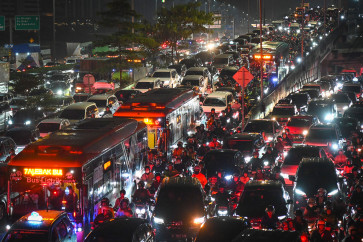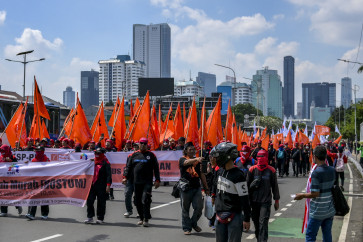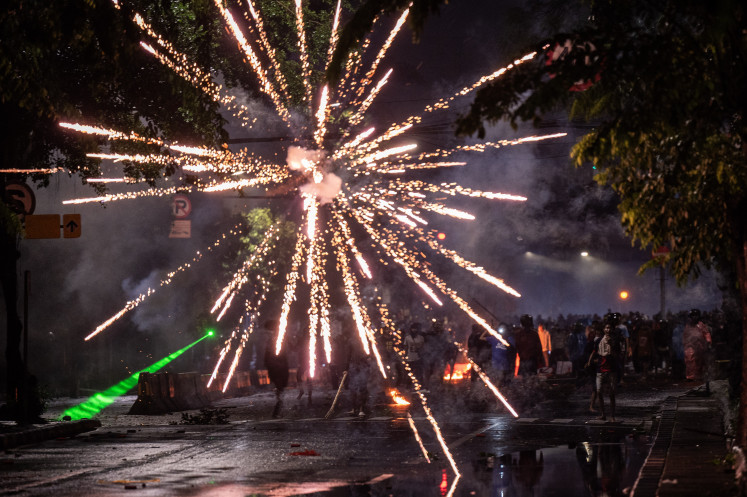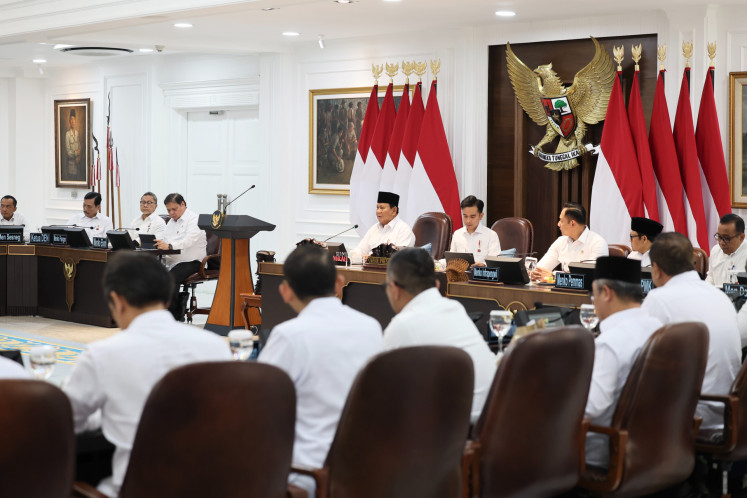Popular Reads
Top Results
Can't find what you're looking for?
View all search resultsPopular Reads
Top Results
Can't find what you're looking for?
View all search resultsIn pursuit of Art tourism
“You actually don’t want to make art as a commercial thing – because everything about art comes from the heart
Change text size
Gift Premium Articles
to Anyone
“You actually don’t want to make art as a commercial thing – because everything about art comes from the heart. But making it a tourism product, yes, you would want to do that – because it’s a positive thing.”
Art’s attraction: Tourists check out paintings at Atma Alam Batik Art Village in Langkawi.
So acknowledged famous Malaysian artist Suhaimi Fadzir of his enthusiasm in the wave of art tourism, which has just started to roll in his homeland.
Positive like he said, the new and innovative tourism campaign embraced by the Malaysian government was more than just attracting tourists — it also opens the eyes of both local and international citizens to the richness of Malaysian art.
“The people here are not aware of and appreciate their own local arts,” Suhaimi said. “Love of art doesn’t start from early education here. We’re introduced to art a little bit late.”
Thus, Suhaimi said, such a government campaign would be the first step to bringing art to the forefront. If it means a good thing for artists like him, it may also be for the Malaysian government, who is now thriving to offer travelers with more than just lovely scenery, vibrant traditions and palate-pleasing cuisine.
In the wake of art tourism, where the artistic energy of art enhances one country’s global appeal, Malaysia does not want to be left behind. While Singapore has already announced it wanted to make the country the Southeast Asia’s center for arts, Malaysia now is embracing the same desire. This desire to mold the country as a melting pot for art aficionados, gallery owners, artists and a new generation of collectors from across the globe, has now located art in the heart of Malaysia’s tourism scene.
“The global traveler today is not looking for destinations but experiences,” said Tan Sri Muhyiddin Yassin, Malaysian Deputy Prime Minister. A strong art tourism scene, he continued, would “enhance our global appeal and keep our tourism offering fresh, new and exciting”.
At first, Yassin admitted, it might seem that art and tourism were two separate things. However, closer observation reveals that they both indeed strive for the same things.
“Tourism and art open the eyes of the world to a society’s culture, social structure and history,” he said during the launching of the Malaysia Contemporary Art Tourism (MCAT) Festival earlier this month.
“Both encapsulate the life, spirit, culture and heritage of a country and its society,” he added.
Beside, as revealed by Malaysian Tourism Minister Dato’ Sri Dr. Ng Yen Yen, it was through art that the beauty and identity of Malaysia could be spread across the world.
“Malaysian art is the canvas upon which our culture, our lifestyle, our landscape and people are featured,” Ng said. “It is an important — and beautiful — documentation of Malaysia, the state of our country, the feelings of our people, the sense of nationhood,” she added.
For art and money: Malaysian artist Suhaimi Fadzir poses in front of an example of his work. The Malaysian government has confidence in the industry — an artist like Suhaimi is able to sell a work for US$40,000.
The wave of art tourism has actually been pulsating across European countries, with people keen to fly across the seas just to see the pieces of Vincent van Gogh, Leonardo da Vinci, Pablo Picasso and Rembrandt van Rijn, or splurge thousands or even millions of dollars to own a painting. Malaysia recognizes this would stimulate the travel industry, so when it launched the MCAT, its goal is clear: To attract unique and distinctive travelers — those high-yield tourists — who can afford the finer things in life. The Malaysian government reference for success, according to Ng, was the 2009 Singapore Biennale, which attracted around 500,000 interested tourists.
“I have no doubt that [through art] the tourism industry will be able to attract a greater numbers of high net-worth tourists willing to pay a premium price for a first-rate experience,” said Yassin during the MCAT’s launching.
So, why contemporary art?
“Contemporary art is a passion that unites discerning travelers and tourists alike from all corners of the world,” reasoned Ng. “[It] has always attracted international attention globally.”
Contemporary art, the way the campaign defines it, is artistic expression of the here and now — broadly spanning a 10-year period. In the context of a modern Malaysian art movement, the contemporary art scene mainly profiles seminal artworks and artists that are prolific and innovative in the here and now — the thread of which spans in the last 10 years.
“I have checked and been informed that Malaysia has thriving clusters of contemporary art segments,” Ng said. “A check on the Internet shows websites such as arterimalaysia.com, which blog about contemporary art and culture around Malaysia and Southeast Asia.”
Ng revealed that with around 400 contemporary artists that Malaysia has — and the big potential they have for the international market, the success of the country’s contemporary art scene was like “fruit ready to be picked”.
Soccer snapshots: A visitor takes a close look at works of the Residency Artist Ada Lama Kini at the Underwater Gallery in Langkawi, Malaysia. The artists attempted to convey “World Cup Fever”.
“I was made to understand that Malaysia contemporary art pieces are set to fetch very good prices ranging from 4,000 ringgit (US$1,250) to 400,000 ringgit with the introduction by Henry Butcher auction,” she said. “This will contribute to the economic spin-off and tourism revenue when tourists purchase items.”
Sharing similar optimism with Ng, Yassin is confident that Malaysian contemporary artworks will find a new niche in the tourism industry,
“I am told that since 2006, prices for the better-known Malaysian modern artists have soared — 100 fold in extreme cases such as the internationally known Ahmad Zakii Anwar — as the general demand for Asian works have reached international markets,” revealed Yassin. Moreover, “over the last two years, many major art exhibitions by Malaysian artists have been sold out. Malaysian artists are winning more commissions from Japanese and European museums and are being invited to prestigious biennales around the world.”
Thus, the MCAT, which will be held from July to September this year, serves as a launching pad for the entry of Malaysia as a serious player in the regional art scene. The festival, Ng said, would place her country alongside art exhibitions around the world, such as the Beijing Contemporary Art Fair, the Dubai Contemporary Art Fair, Vienna Art Fair and Hong Kong Art and Antiques Fair.
“We have outlined an extensive promotional plan to market Malaysia as the center for contemporary art in the Asian region,” revealed Ng, the mastermind of MCAT. “As you can witness today, we have invited art critics and writers from the United States, Italy and Hong Kong — all are serious players in the art congregation.
“We also have included a 30-minute program with BBC Worldwide, United Kingdom, to promote further the contemporary art segment to the international market with a total coverage of 4.6 million viewers in Europe, Asia Pacific, Middle East and South Africa,” she added.
With the tourism industry being the second highest income earner for Malaysia’s economy after manufacturing, the country is making new initiatives to draw foreign tourists. The Malaysian government recorded more than 23 million tourist arrivals in the country in 2009, an increase from around 22 million the previous year.
Singapore, Indonesia and Thailand are the top-three countries contributing to the figure. By creating new and innovative tourism products such as the MCAT, “the nation’s profile could be boosted as a top tourist destination, and simultaneously, contribute toward its economic growth,” Yassin said.
The MCAT will be held in Kuala Lumpur, Penang, Malacca and Johor. The festival is showcasing what Ng called “the most explosive, dynamic and provocative artworks” by internationally acclaimed Malaysian artists, as well as upcoming contemporary artists from all over the country. Among the artists are Malaysia’s leading contemporary sculptor Abdul Muthalib Musa, Fauzan Omar, Annuar Rashid, Yusoff Ghani, Eng Hwee Chu, A. Jegadeva and Dhavinder Gill.
The artists’ paintings, sculptures and other artworks are now being revealed for the first time to the public at Kuala Lumpur’s Galeria Sri Perdana, Starhill Art Gallery, National Art Gallery, Petronas Gallery, Malaysia Tourism Center and the Central Market, as well as at Malacca’s Folk Art Gallery and Johor’s Danga City Mall.
“Our young talents can share their artistic energy via blogs or Twitter about what they have seen, done or think about the limitless aspect of art, favorite Malaysian art centers, icons, works and so on,” Ng said.
“Who knows, the next Picasso or Andy Warhol of Malaysia will be discovered by a world audience via art lovers.”
— Photos by JP/Dian Kuswandini












